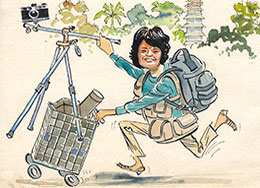.jpg)
Blue tits love feeding on ripe Japanese dogwood (Cornus kousa) fruits; this one has extracted a seed.
Instead of ambling out and photographing whatever turns up, I prefer to have a project with target species to aim for each time I venture out into the field. In this way, I can weave a story around unrelated species by their behaviour or a biological topic. For this blog, I have chosen to write about seed dispersal.
Seeds are dispersed by water, wind and animals.
Water
.jpg)
Japanese iris (Iris ensata) seeds float hanging from the surface, lit by sun late in the day.
Several aquatic and marginal plants, including aquatic irises, produce seeds that float and get carried away from the parent plant by water currents. On a much bigger scale, the coco de mer from the Seychelles and the coconut are two tropical palms, which produce large fruits that are dispersed by floating in the sea.
.jpg)
A coconut carried in the sea is washed ashore on a sandy beach in the Seychelles.
Wind
Any plant that produces many wind-born seeds, each with a hairy pappus, can be taken as the wind plucks them from the dry fruit casing. This is most effective when shot against the light. Both milkweed and rosebay willow herb make good subjects here.

Milkweed (Asclepias) pod splits to release parachute seeds dispersed by wind.
When seeds of trees or vines with large bracts or wings are released from their fruits, they descend more slowly in a zigzag motion, which helps to ensure they drop down away from the parent plant. Capturing these seeds in mid-flight in the field is not impossible, but can be time consuming. The flying gourd seeds were taken in the studio using a light trip beam and high speed flash.
 The flying gourd or Javan cucumber (Alsomitra macrocarpa) from Malay Archipelago has giant winged seeds.
The flying gourd or Javan cucumber (Alsomitra macrocarpa) from Malay Archipelago has giant winged seeds.
Dispersal of poppy seeds takes place when the capsule dries out and pores open in a circle near the top. When the wind blows the stem back and forth, seeds are thrown out like a hand shaking a pepper pot.

Seed scattered from Welsh poppy (Meconopsis cambrica) capsule by stalk shaken in wind.
Animals
Many animals disperse seeds by gorging on ripe fruits and passing seeds out through their gut. When acorns and chestnuts are ripe, squirrels busily collect them from beneath trees, carrying them away to bury in the ground as a cache for later retrieval. Some are never unearthed and this is how oak and chestnuts seedlings appear in lawns or verges far removed from the parent tree.

A grey squirrel carries sweet chestnut (Castanea sativa) fruit in mouth to cache in ground.
Any animals that feast on seeds within attractive fruits still on the tree, reduce the number of intact seeds for germination. However, in the process some are loosened and drop to the ground. At Kew Gardens, squirrels and ravens have learnt to wait beneath sweet chestnut trees when parakeets are feeding above for an easy bounty to fall.

Dormouse (Muscardinus avellanarius) feeds on blackberries in autumn.
Animals eating fruit makes a much more interesting image than fruit alone and in this case longer lenses will be needed. In places where wildlife is habituated to humans, a 300mm lens maybe enough; elsewhere at least 400mm or even a 500mm lens will be better for achieving successful shots without animals being spooked.

Blackbird (Turdus merula) with gelatinous red yew aril that contains a single seed.
Animals, as well as and humans, also aid dispersal of hooked seeds and fruits that become attached to their fur, feathers or clothing. These include small round cleavers (also known as clinging sweethearts), burdock and wood avens. When turn-ups were once fashionable on men’s trousers, many seeds ended up in turn-ups not tucked into boots.

Hooked achenes of wood avens (Geum urbanum) are readily picked up in the fur of passing mammals.
Some seeds have large hooks that become impaled in hooves or fetlocks of ungulates where they can result in injury or infection. Eventually the seed is released – often at some distance from where it was picked up.

The worlds largest hitchhiking fruit is devils claw (Proboscidea parviflora) from North America.
Here are just a few examples of seed dispersal and autumn is a good time to look around for others, especially on trees and shrubs.
Thanks for reading!


